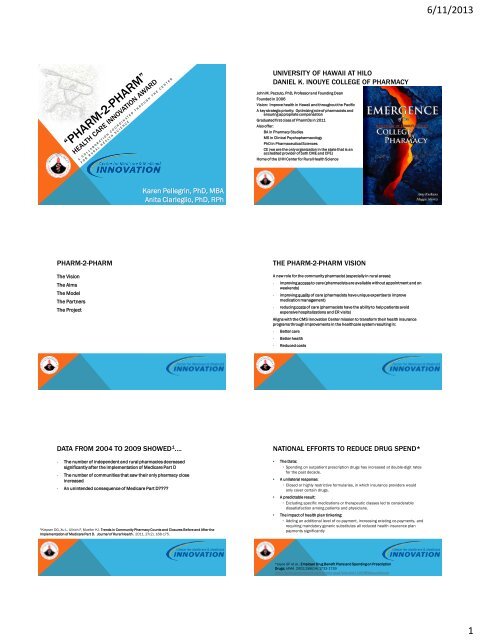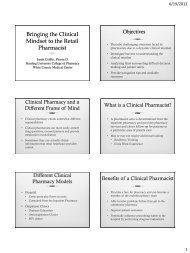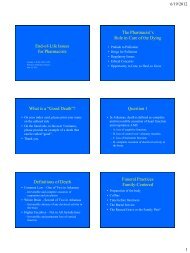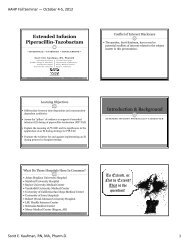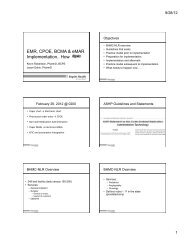Karen Pellegrin, PhD, MBA Anita Ciarleglio, PhD, RPh UNIVERSITY ...
Karen Pellegrin, PhD, MBA Anita Ciarleglio, PhD, RPh UNIVERSITY ...
Karen Pellegrin, PhD, MBA Anita Ciarleglio, PhD, RPh UNIVERSITY ...
Create successful ePaper yourself
Turn your PDF publications into a flip-book with our unique Google optimized e-Paper software.
6/11/2013<br />
<strong>UNIVERSITY</strong> OF HAWAII AT HILO<br />
DANIEL K. INOUYE COLLEGE OF PHARMACY<br />
John M. Pezzuto, <strong>PhD</strong>, Professor and Founding Dean<br />
Founded in 2006<br />
Vision: Improve health in Hawaii and throughout the Pacific<br />
A key strategic priority: Optimizing role of pharmacists and<br />
ensuring appropriate compensation<br />
Graduated first class of PharmDs in 2011<br />
Also offer:<br />
BA in Pharmacy Studies<br />
MS in Clinical Psychopharmacology<br />
<strong>PhD</strong> in Pharmaceutical Sciences<br />
CE (we are the only organization in the state that is an<br />
accredited provider of both CME and CPE)<br />
Home of the UHH Center for Rural Health Science<br />
<strong>Karen</strong> <strong>Pellegrin</strong>, <strong>PhD</strong>, <strong>MBA</strong><br />
<strong>Anita</strong> <strong>Ciarleglio</strong>, <strong>PhD</strong>, <strong>RPh</strong><br />
PHARM-2-PHARM<br />
The Vision<br />
The Aims<br />
The Model<br />
The Partners<br />
The Project<br />
THE PHARM-2-PHARM VISION<br />
A new role for the community pharmacist (especially in rural areas):<br />
- improving access to care (pharmacists are available without appointment and on<br />
weekends)<br />
- improving quality of care (pharmacists have unique expertise to improve<br />
medication management)<br />
- reducing costs of care (pharmacists have the ability to help patients avoid<br />
expensive hospitalizations and ER visits)<br />
Aligns with the CMS Innovation Center mission to transform their health insurance<br />
programs through improvements in the healthcare system resulting in:<br />
- Better care<br />
- Better health<br />
- Reduced costs<br />
DATA FROM 2004 TO 2009 SHOWED 1 ….<br />
- The number of independent and rural pharmacies decreased<br />
significantly after the implementation of Medicare Part D<br />
- The number of communities that saw their only pharmacy close<br />
increased<br />
- An unintended consequence of Medicare Part D????<br />
1 Klepser DG, Xu L, Ullrich F, Mueller KJ. Trends in Community Pharmacy Counts and Closures Before and After the<br />
Implementation of Medicare Part D. Journal of Rural Health. 2011, 27(2), 168-175.<br />
NATIONAL EFFORTS TO REDUCE DRUG SPEND*<br />
• The Data:<br />
• Spending on outpatient prescription drugs has increased at double-digit rates<br />
for the past decade.<br />
• A unilateral response:<br />
• Closed or highly restrictive formularies, in which insurance providers would<br />
only cover certain drugs.<br />
• A predictable result:<br />
• Excluding specific medications or therapeutic classes led to considerable<br />
dissatisfaction among patients and physicians.<br />
• The impact of health plan tinkering:<br />
• Adding an additional level of co-payment, increasing existing co-payments, and<br />
requiring mandatory generic substitutes all reduced health insurance plan<br />
payments significantly<br />
*Joyce GF et al., Employer Drug Benefit Plans and Spending on Prescription<br />
Drugs; JAMA. 2002;288(14):1733-1739<br />
http://jama.jamanetwork.com/article.aspx?articleid=195389#qundefined<br />
1
6/11/2013<br />
DRUG SPEND PROBLEM SOLVED?<br />
A BETTER APPROACH….<br />
• Authors’ worries*:<br />
• “Pharmacy benefit managers and their sponsors may be designing<br />
prescription benefit packages that reduce the costs of pharmaceuticals but<br />
increase overall medical costs”<br />
• “There is little evidence about whether lower pharmaceutical use resulting<br />
from higher patient cost-sharing adversely affects clinical outcomes”<br />
• Can these worries be addressed with better data and collaboration?<br />
• *“Beginning in 1999, Fairview Health Services of Minneapolis/St. Paul<br />
implemented the Collaborative Practice of Pharmaceutical Care at 6 of 15<br />
primary care clinics, where pharmacists now play an integral role in the delivery of<br />
care”<br />
• *RESULTS:<br />
• Improvements in clinical outcomes<br />
• Reductions in cost<br />
*Joyce GF et al., Employer Drug Benefit Plans and Spending on Prescription<br />
Drugs; JAMA. 2002;288(14):1733-1739<br />
http://jama.jamanetwork.com/article.aspx?articleid=195389#qundefined<br />
*Isetts et al., Clinical and economic outcomes of medication therapy<br />
management services: The Minnesota experience.<br />
J Am Pharm Assoc. 2008;48:203-214<br />
http://japha.org/article.aspx?articleid=1043431#Methods<br />
IMPROVED OUTCOMES<br />
REDUCED TOTAL COST OF CARE (NOTE INCREASE IN DRUG COSTS)<br />
*Isetts et al., Clinical and economic outcomes of medication therapy<br />
management services: The Minnesota experience.<br />
J Am Pharm Assoc. 2008;48:203-214<br />
http://japha.org/article.aspx?articleid=1043431#Methods<br />
*Isetts et al., Clinical and<br />
economic outcomes of<br />
medication therapy<br />
management services: The<br />
Minnesota experience.<br />
J Am Pharm<br />
Assoc. 2008;48:203-214<br />
http://japha.org/article.aspx?<br />
articleid=1043431#Methods<br />
WHY NOW?<br />
NO LONGER A PHARMACIST SHORTAGE?<br />
Previous obstacles to community pharmacy innovation:<br />
- Lack of payment/reimbursement<br />
- Lack of pharmacists (workforce shortage)<br />
CMS funding to “support local projects in communities across the nation that aim to deliver<br />
better care and better health at lower costs”<br />
- Health Care Innovation Award program<br />
- $1 billion in awards<br />
- Pharm2Pharm is one of 107 projects selected out of about 3,000 (only a few of these<br />
selected projects involve leveraging community pharmacists)<br />
- Pharm2Pharm project will pay community pharmacists $695 per patient enrolled per<br />
year on the assumption that there will be ROI to CMS<br />
http://www.pharmacymanpower.com/about.jsp<br />
2
6/11/2013<br />
DEMAND BY PRACTICE SETTING: MARCH 2013<br />
Region and Divisional Demand Index - Mar 2013<br />
Regions and divisions refer to geographic areas defined by the U.S. Bureau of the Census.<br />
Setting<br />
Community<br />
Institutional<br />
Multiple<br />
Demand Index<br />
2.78<br />
3.22<br />
3.23<br />
A community<br />
pharmacist glut?<br />
Community refers to community pharmacists of all types: independent, chain, supermarket and<br />
mass merchandisers.<br />
Institutional refers to pharmacies affiliated with hospitals and healthcare systems.<br />
Multiple refers to pharmacies affiliated with large organizations that include community, clinic<br />
and inpatient pharmacies.<br />
Region/Division States Demand Index<br />
Northeast 2.50<br />
New England CT, MA, ME, NH, RI, VT 2.44<br />
Middle Atlantic NJ, NY, PA 2.52<br />
South 3.26<br />
South Atlantic DE, DC, FL, GA, MD, NC, SC, VA, WV 2.95<br />
East South Central AL, KY, MS, TN 3.39<br />
West South Central AR, LA, OK, TX 3.71<br />
Midwest 3.18<br />
East North Central IL, IN, MI, OH, WI 3.09<br />
West North Central IA, KS, MN, MO, NE, ND, SD 3.39<br />
West 3.48<br />
Mountain AZ, CO, ID, MT, NV, NM, UT, WY 3.17<br />
Pacific AK, CA, HI, OR, WA 3.61<br />
A CRITICAL TIME FOR PHARMACISTS<br />
2010: “Over the past year or so, the pharmacy<br />
job market has turned 180° from a candidatedriven<br />
market to an employer-driven market”<br />
(http://www.pharmacytimes.com/publications/issue/2010/June2010/PharmacyJobTrends-<br />
0610)<br />
THE GOOD NEWS<br />
Unprecedented national focus on improving<br />
healthcare quality & cost-efficiency<br />
Extensive evidence that expanding services<br />
offered by pharmacists accomplishes both<br />
(http://www.usphs.gov/corpslinks/pharmacy/comms/pdf/2011advancedp<br />
harmacypracticereporttotheussg.pdf)<br />
OFFICE OF THE CHIEF PHARMACIST:<br />
A REPORT TO THE U.S. SURGEON GENERAL 2011<br />
“Failure to recognize expanded roles of pharmacists limits the potential for<br />
patients and our health care system to benefit from access to additional quality<br />
primary care services. Exclusion of pharmacists as health care providers also<br />
eliminates any subsequent service-sustaining compensation. Pharmacists are<br />
increasingly requested by many health systems, providers, and primary care<br />
teams to improve outcomes and delivery of care. However, in terms of<br />
pharmacist services, as the complexity or level of clinical service increases, the<br />
revenue generation potential is reduced. This is in stark contrast to the clinical<br />
services provided by other health professionals.”<br />
Giberson S, Yoder S, Lee MP. Improving Patient and Health System Outcomes through Advanced Pharmacy Practice.<br />
A Report to the U.S. Surgeon General. Office of the Chief Pharmacist. U.S. Public Health Service. Dec 2011.<br />
ASSESSING TRUE DEMAND<br />
“Demand” = ease of filling open positions by employers (e.g., Pharmacy<br />
Manpower Project)<br />
• Does not accurately reflect need for pharmacists for optimal patient care<br />
(i.e., captures only one aspect of demand)<br />
• Distortions due to payers not recognizing pharmacists as providers<br />
“Demand” = the number of pharmacists required to improve healthcare quality<br />
and cost-efficiency<br />
• Is more accurate (i.e., takes a broader view of demand)<br />
• Is much greater<br />
• e.g., HRSA: pharmacist demand derived from demand for pharmaceuticals<br />
and role of pharmacists in providing medication services that patients<br />
require (http://bhpr.hrsa.gov/healthworkforce/reports/pharmsupply20042030.pdf)<br />
3
6/11/2013<br />
PHARM-2-PHARM AIMS<br />
Better health<br />
Better care<br />
Lower costs<br />
60%<br />
50%<br />
% population growth 1990-2010<br />
50%<br />
Specifically, reduce annual<br />
medication-related<br />
hospitalizations & ER visit rates<br />
and total cost of care among<br />
elderly/others at risk in rural<br />
Hawaii*<br />
40%<br />
30%<br />
20%<br />
14%<br />
*According to Hawaii Health Information Corporation, there were over 15,000 medication-related ER<br />
visits and over 700 medication-related hospitalizations among elderly in rural counties of Hawaii in<br />
2010, resulting in over $63,000,000 in charges to payers.<br />
10%<br />
0%<br />
Honolulu County<br />
Rural Counties (Hawaii,<br />
Kauai, & Maui)<br />
60%<br />
50%<br />
40%<br />
30%<br />
Projected HI population growth 2010-2040<br />
53%<br />
MODEL<br />
A formal hospital pharmacist-to-community pharmacist collaboration (called<br />
“pharmacist-to-pharmacist” or “Pharm2Pharm”)<br />
Designed to address gaps in care among patients at risk as they transition from<br />
hospital to community settings<br />
Designed to leverage accessibility of community pharmacists in rural Hawaii*<br />
20%<br />
14%<br />
10%<br />
0%<br />
Honolulu County<br />
Rural Counties<br />
*In Hawaii, the 2012 physician shortage in the metropolitan county of Honolulu is 13% of current supply compared<br />
to a shortage of 44% across the three rural counties targeted in this project<br />
(http://www.ahec.hawaii.edu/workforce.html)<br />
4
6/11/2013<br />
MODEL INNOVATIONS<br />
Pharmacists collaborating across the continuum of care<br />
Pharmacist review of medication reconciliation*<br />
Pharmacist-coordinated medication management**<br />
Integration of pharmacists into care teams<br />
Payment restructuring for pharmacist services<br />
PARTNERS<br />
Operating partners<br />
- Rural hospitals<br />
- Hawaii Community Pharmacist Association members<br />
Other partners<br />
- Hawaii Health Information Exchange (our state-designated entity)<br />
- Hawaii Health Information Corporation<br />
- Altarum Institute<br />
*Hospital pharmacists found unexplained discrepancies between preadmission medication regimens and discharge<br />
medication orders in 49% of all general medicine patients in a large teaching hospital 1<br />
**Ambulatory care pharmacist consultations focused on selected high-risk patients resulted in significantly lower<br />
non-elective hospitalization and mortality 2<br />
1 Role of Pharmacist Counseling in Preventing Adverse Drug Events After Hospitalization. Schnipper, et al.,<br />
2006, Archives of Internal Medicine, 166: 565-571.<br />
2 Effects of Ambulatory-Care Pharmacist Consultation on Mortality and Hospitalization. Yuan, et al., 2003,<br />
American Journal of Managed Care, 9(1): 45-56<br />
PROJECT<br />
• 3 year cooperative agreement<br />
• July 1, 2012 through June 30, 2015<br />
• Total award = $14.3MM<br />
• Budget approval annually<br />
• Target savings = $27.1MM in cost avoidance<br />
PROJECT WORK-STREAMS<br />
Workforce development<br />
Re-tool current pharmacies via CPE<br />
Adapt PharmD student rotations<br />
Pharm2Pharm service operations<br />
Standard operating procedures<br />
Medication protocols<br />
Collaborative practice agreements<br />
Supporting HIT<br />
Surescripts network interface with HHIE<br />
Rural hospital interface with HHIE<br />
EMR and Secure Electronic Communication for community pharmacists<br />
Project administration<br />
Staffing<br />
Administering contracts<br />
Planning, Monitoring and Evaluation<br />
CMS communications<br />
CARE COORDINATION….<br />
The Promise<br />
The Puzzle<br />
U.S. HEALTH CARE EXPENDITURES<br />
HEALTH SERVICES RESEARCH<br />
VOLUME 46, ISSUE 2, PAGES 479-490, 19 NOV 2010 DOI: 10.1111/J.1475-<br />
6773.2010.01212.X<br />
HTTP://ONLINELIBRARY.WILEY.COM/DOI/10.1111/J.1475-6773.2010.01212.X/FULL#F1<br />
5
6/11/2013<br />
OVERALL RESULTS<br />
FFS Medicare patients who volunteered to<br />
participate between April 2002 and June 2005<br />
were randomly assigned to treatment or<br />
control (usual care) status<br />
Each program received a negotiated monthly fee<br />
per patient from Medicare<br />
• >18,000 patients<br />
• Initially 4 years<br />
• Hosted at disease management centers,<br />
academic, hospice, LTC, CH, retirement<br />
• Targeted CHF, CAD, DM, COPD<br />
Only 2 of the 15 programs showed significant reductions in hospitalizations and Medicare<br />
expenditures<br />
However one of those was not viable and dropped out of the project<br />
None of the programs generated net savings<br />
None of the programs improved adherence measures<br />
Only a few of the many quality indicators showed improvement<br />
PEIKES ET AL., 2009, JAMA, 301(6):603-618<br />
MINING THE SUCCESSES<br />
TOP 2 VS. OTHERS<br />
DIFFERENTIATING<br />
FEATURES:<br />
Top 2<br />
Others (10 with sufficient<br />
sample size)<br />
The most successful program, Health Quality Partners, risk-stratified its patients at enrollment<br />
Treatment-control group differences were concentrated entirely in the program’s highest<br />
severity cases (approximately 30% of the sample)<br />
# of in-person contacts<br />
per month per patient<br />
Population enrolled<br />
Nearly 1 Median of 0.3<br />
Average monthly<br />
Medicare expenditures of<br />
$900-$1200<br />
Less targeted mix<br />
(including some higher<br />
and lower)<br />
Teaching enrollees<br />
how to take their meds<br />
Yes Only 1 out of 10<br />
Local hospital<br />
collaboration<br />
Opportunities to<br />
interact informally with<br />
physicians<br />
Close collaboration<br />
Frequent opportunities /<br />
continuity of care<br />
coordinator per physician<br />
Less so<br />
Only 2 out of 10<br />
Hospital<br />
Consulting<br />
Pharmacist<br />
•Screen/enroll<br />
•Med rec<br />
•Education<br />
•Formal handoff<br />
DISCHARGE<br />
Community<br />
Consulting<br />
Pharmacist<br />
•Immediate<br />
contact<br />
•> 12 visits<br />
•> Quarterly<br />
updates to<br />
prescribers<br />
END OF ONE YEAR<br />
GOAL<br />
•Improve health<br />
•Prevent ER<br />
visits<br />
•Prevent readmissions<br />
•Lower total<br />
cost of care<br />
If age < 65, meet all 5<br />
If age > 65, meet at least 4<br />
Include<br />
On med(s) with narrow therapeutic<br />
index<br />
On med(s) with risk of adverse events<br />
On 5+ meds (i.e., Rx med, aspirin)<br />
Has 3 or more chronic comorbid<br />
conditions<br />
ER visit and/or non-elective<br />
hospitalization w/in past year<br />
HCP<br />
may<br />
override<br />
Exclude<br />
Not expected to be d/c’d to home (e.g.,<br />
SNF, hospice)<br />
Not full-time county resident<br />
Dementia / psychosis<br />
Hospitalization related to suicide<br />
attempt<br />
Death<br />
Hospital<br />
Consulting<br />
Pharmacist<br />
AMA<br />
“Imminent discharge”<br />
6
6/11/2013<br />
Hospital<br />
Consulting<br />
Pharmacist<br />
General<br />
• Patient is at risk<br />
• Importance of taking meds<br />
properly<br />
• Disease states<br />
• Community pharmacy selection<br />
Hospital<br />
Consulting<br />
Pharmacist<br />
Reconcile with home<br />
meds<br />
Compare with<br />
med rec from<br />
nurse<br />
Resolve any<br />
discrepancies<br />
Specific<br />
• Purpose of each med<br />
• Monitoring each med<br />
• Potential side effects<br />
• How to take each med<br />
• Which meds NOT to take<br />
Information<br />
transmitted<br />
to CCP<br />
Demographics<br />
Allergies<br />
Nursing assessment of ADLs<br />
Hospital<br />
Consulting<br />
Pharmacist<br />
Within 1 day of<br />
discharge…<br />
Community<br />
Consulting<br />
Pharmacist<br />
Discharge care plan<br />
Preadmission medications<br />
Confirm patient picked up meds<br />
Discharge medications<br />
Follow up physician/contact<br />
Primary care provider/contact<br />
HCP clinical notes<br />
HCP contact info<br />
Confirm patient understands<br />
meds (what to take and not to<br />
take, and how)<br />
Confirm patient has an<br />
appointment with follow up<br />
provider<br />
Schedule Visit 1 within 3 days of<br />
discharge<br />
Patient visit with CCP<br />
• Functional status<br />
• Patient’s goals<br />
• Med rec<br />
• Drug therapy problems<br />
• Adherence counseling/coaching<br />
CCP follow up with prescribers (if needed)<br />
• Recommend solutions to drug therapy problems<br />
Community<br />
Consulting<br />
Pharmacist<br />
THREE-YEAR FOCUS<br />
LAUNCH<br />
Year 1<br />
- Staff<br />
- Contracts<br />
- SOPs & tools<br />
- Training<br />
- Evaluation Plan<br />
- Enrollment<br />
IMPROVE<br />
Year 2<br />
- CQI<br />
- HIT<br />
- Provider collaborations<br />
SUSTAIN<br />
Year 3<br />
- Payment models<br />
- Partnerships<br />
7
6/11/2013<br />
ACKNOWLEDGEMENT OF FEDERAL FUNDING<br />
The project described is supported by Funding Opportunity Number CMS-1C1-12-<br />
0001 from Centers for Medicare and Medicaid Services, Center for Medicare and<br />
Medicaid Innovation.<br />
Its contents are solely the responsibility of the authors and do not necessarily<br />
represent the official views of HHS or any of its agencies.<br />
8


